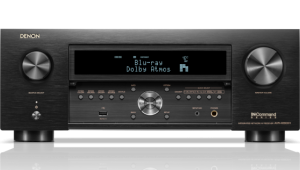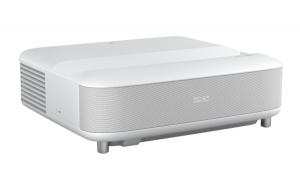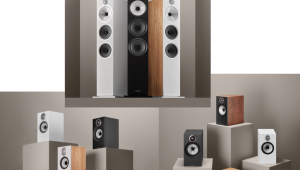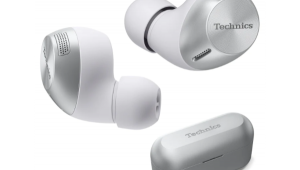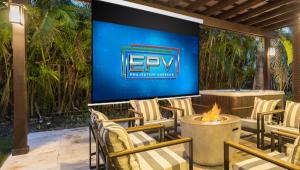Tech Trends 2013: Audio Page 5
High-Flyin' Headphones
Private listening expands exponentially
Even though everybody knew that CES 2013 would be a big headphone show, one couldn't help but be overwhelmed by the number of new model introductions. I ignored about half the headphone manufacturers I passed, but my coverage on soundandvisionmag.com ended up including 40 different companies.
With so many new models introduced in every headphone category - on-ear, over-ear, in-ear, noise-canceling, Bluetooth, etc. - it's hard to cite an especially hot trend. Unless, of course, it's the continuing expansion of celebrity endorsements. CES saw headphones branded with the names of such unlikely endorsers as Snooki (from Jersey Shore), Motörhead frontman Lemmy Kilmister, and football legend Tim Tebow.
Of all the new celeb headphones, only the Motörheadphones really impressed me. You'd think a Motörheadphöne might sound like those ultra-bass-heavy hip-hop headphones, but no - the top-of-the-line Motörizer over-ear I heard sounded surprisingly refined, even when I switched from "Ace of Spades" to "Aja." The line also includes another over-ear model, an on-ear, and two all-metal (of course!) in-ear monitors, at reasonable prices ranging from $49 to $129. [Editor's Note: We don't know how real this product is. We have asked for a review sample three times, and been promised one twice. We haven't been able to find a U.S. retailer who carries them. The PR person didn't respond to our last e-mail.]
I expected to see a whole lot of new Bluetooth headphones appear this year, and while there will be some interesting wireless models coming out this season, most rely on good old-fashioned wires. The most interesting new Bluetooth 'phone is surely the JayBird BlueBuds X ($169), a sports-style in-ear monitor which we reviewed last month and loved. Most in-ear wireless headphones come with a bulky Bluetooth module that clips onto your clothes, but JayBird built the Bluetooth, the amps, and the rechargeable battery right into the BlueBuds X's tiny earpieces.
Another Bluetooth standout was from (former) subwoofer specialist Velodyne, which has expanded into on-ear and over-ear headphones. The company's $299 vFree on-ear headphone artfully blends the Bluetooth controls into the right earpiece. You can even buy skins that customize the look. Velodyne also launched the vTrue, a $399 over-ear passive model that seems aimed straight at audiophiles. Aluminum construction and supple leather earpads give the vTrue the comfort needed for long listening sessions. For more info, read our reviews of the vFree and vTrue.
Speaking of audiophile headphones, this season's most auspicious debut is surely the $299 AudioTechnica ATH-AD900X, an upgraded, more robust version of the ATH-AD900 we loved in last year's review of audiophile headphones. The open-back ATH-AD900X delivers a huge soundstage with excellent detail, and the light weight and soft earpads make it exceptionally comfortable. (Review coming very soon.)
Just as every celeb seems to want his or her own line of headphones, pretty much every audio company wants into the hot, hot headphone biz. The latest is Onkyo, already revered for its receivers but hoping to branch out. The new line includes over-ear models at $149 and $179, and in-ear models at $99 and $129. The difference between the base and upgraded models is that the more expensive ones have high-performance cables made from oxygen-free copper. All models use titanium drivers and dual-chamber construction for tighter, better-defined bass.
Nice as the Onkyo prototypes sounded at CES, it's the new Gibson by Onkyo headphones that got all the attention. The headphones bear the Gibson logo across either sunburst or gold earcups, to match the classic finishes of Gibson Les Paul guitars. At press time, it still wasn't certain if these would actually go into production, but given the positive buzz at CES, they'd be crazy not to.
Onkyo wasn't the only audio electronics company to debut headphones at CES. NAD, best known for its no-frills, audiophile-grade integrated amps, launched the $279 Viso HP50. NAD benefits from the acoustical engineering expertise of Paul Barton, founder of PSB Speakers, which like NAD is owned by The Lenbrook Group. Thus, the HP50 is similar to the NAD M4U 1, the passive version of the M4U 2, S&V's 2012 Product of the Year. The difference, according to Barton, is that the HP50 has a bit more bass.
Harman Kardon got into the headphone biz last year, and it must have done well because it's expanding. The company's new top-of-the-line model is the $299 NC, a noise-canceling version of the stylish, rectangular CL introduced last year. For better noise canceling, it uses microphones inside and outside the earpieces. The 40mm drivers work in passive mode, too, so the sound doesn't stop when the battery runs down.
To my surprise, the NC was one of only two high-profile launches of a noise-canceling headphone at CES. (The other was the $299 Paradigm H15NC on-ear.) Headphone companies don't seem to have been putting much energy into noise-canceling technology of late. Perhaps they're content to leave the category to Bose, whose QuietComfort 15 still dominates the passenger cabins of jet airliners around the world. The QC15 costs $299, though, and noise-canceling technology isn't all that terribly expensive to do: a little one-chip amplifier, a couple of microphones, a simple (in most cases) noise-canceling circuit, and a battery.
Thus, I've expected some company to come in with a decent $99 noise-canceling headphone that could steal budget-minded headphone buyers away from Bose. We've tested a few such cheapies, but they've all sounded lousy. Finally, this spring we're seeing the debut of a $99 noise-canceling headphone that might be worth buying: the NoiseHush i7, a design that is clearly "influenced" (to put it as charitably as we can) by the QC15. No, the i7 can't match the QC-15's respectable sound quality or class-leading noise cancellation, but it seemed pretty decent in my brief listen. And unlike the QC15, it works with the noisecanceling switched off and when the battery dies.
Of course, the easy and less expensive way to cut ambient noise is to block it physically, which any in-ear monitor can do reasonably well because its silicone or foam eartips seal your ear canals. While 2013 will probably see the introduction of hundreds, possibly thousands, of new IEMs (no, I'm not kidding), most are generic models that don't get the benefit of careful tuning. However, I did encounter four companies at CES that are doing something really interesting in the category this year.
One is HiFiMan, best known as the maker of bulky yet great-sounding planar magnetic over-ear headphones. Although HiFiMan has made IEMs for years, it hasn't distinguished itself in that segment- but the RE-400 Waterline might change that. According to company founder Dr. Fang Bian, the RE-400 is the result of a three-year project in which the company sought to create a truly superb $99 IEM. After extensive research into ergonomics, driver design, and materials, the RE-400 is finally shipping. The titanium-coated dynamic driver is powered by neodymium magnets. Why the name? Because, according to Bian, the RE-400's competitors are "below the waterline." At press time, a higher-end model, the $399 RE-600, was slated for a spring launch.
Take one look at the Munitio Nines IEMs-shaped like the case of a 9mm pistol cartridge - and you might assume the brand is devoted more to image than to sound quality. But I've heard the $169 Nines and they sound fantastic. So I was excited to see that the companyis introducing a more affordable IEM, the $129 SV. The SV employs a metal/ABS and the company's Silicone Hollow Points tips, which use extra-thin silicone material supported by inner ribs that allow the tips to create a superb seal. Munitio voiced the SV to be more neutral than the Nines, which some (but not me) might consider a little bass-heavy.
It's hard to consider a $199 IEM "downmarket," but for Westone - a company best known for high-end, custom-molded IEMs - the new Adventure Series Alpha is surprisingly affordable. It's the company's first headphone with a standard dynamic driver (like a miniature speaker) instead of balanced-armature drivers. Why the switch? Because the Alpha is designed for outdoor activities, and dynamic drivers are more durable. The removable cable has a three-button iPhone/iPad-compatible remote and a reflective weave for better visibility.
The 2012 CES saw the launch of numerous headphone companies, but it was anyone's guess which ones we'd see return in 2013. One I was betting on was Audiofly, an Australian company that offers IEMs in distinctive designs with competitive prices - and, as my experience with the company's AF78 suggests, solid sound quality. The company is celebrating its initial success with the launch of several higher-end models. The top model is the $399 AF160, which employs triple balance armatures and comes with nine sets of tips, including silicon and Comply foam tips. Two cables are included: one designed for maximum sound quality and one with an inline remote/mike. Also available is the dual balanced armature AF140 for $349 and the $249 hybrid AF120.
Those scanning this article in search of an overriding trend in headphones may be frustrated, so I'll conclude with what I think will be a trend. It's based in part on my discussion with Rex Price, a young acoustical and electrical engineer at Skullcandy. Skullcandy's not currently known for sound quality, but during our discussion, I learned that Price and the rest of the engineering team (headed by Tetsuro Oishi, a Ph.D formerly with Bose) are hip to all the latest studies on headphone voicing, and that the company has recently spent about $100,000 on test equipment. I also learned from the makers of the headphone measurement gear I use that many other companies that have lacked technical expertise are buying test gear, hiring engineers, and working to deliver great sound in their headphones instead of just cool looks. I don't know that all this action will result in better-sounding mass-market headphones, but we can all hope. (Our experience with the recently revoiced Navigator-yep, review coming soon-suggests they're making progress.)
- Log in or register to post comments








